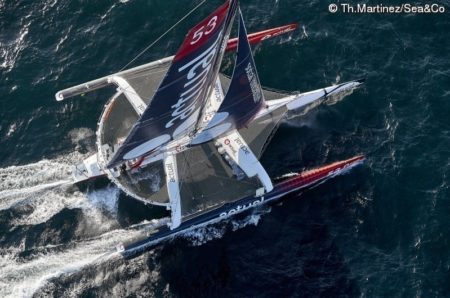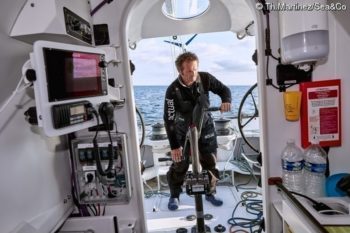Sailing non-stop around the world “the wrong way” is an ambitious challenge! Why going westerly against the trade winds?
I have been thinking about this challenge for a few years and I simply really liked the idea! This is also an excellent training to prepare the Round the World race in 2019. Plus it conveys a meaning that is in line with Team Actual vision and project.
For how long have you been training for this long voyage?
We have been planning and working towards this for about 1 year. We started with the performance part during The Bridge race last June. This led us to make improvements to the boat. Then we enhanced her reliability to avoid any issues as much as possible or to be able to solve any problem that would occur.
Precisely, the Westabout route is a very demanding and unusual one. As it requires a thorough preparation, did you leave room for unexpected events?
Totally! Even if we tried to scan all possibilities, there will always be uncertainties and surprises. We mainly focused on reliability and capacity to navigate rather than pure performance. The priority is to keep the natural potential of the boat speed.
Can you tell us a bit more about the team members and your router?
Team Actual consists of 7 persons working full time. Each member works in a specific field. Engineering, rigging, IT, communication, electronics… I am in permanent contact with each member; they share all information with me.
My router is Christian Dumard. We’ve been working together for a long time! We will mainly share information about routing strategy and tactical choices related to my route. But Christian will also give me his general opinion about the navigation. He will be my main contact, a privileged interlocutor.
What are the assets and limits of the boat?
Actual is a big and fast multihull. As we don’t want to cause any damages, we will only navigate up to 80% of her capacities. Besides, a multihull is more instable than a monohull. Thus there will be a lot of tension onboard.
Any fears?
How the boat will handle after Cape Horn is one of the uncertainties. Another parameter that I am going to discover is the time spent at sea. I am not worried about it but it is going to be a long navigation. I am aware of that.
You are currently on standby, waiting for the best weather conditions to choose a departure date. In practice, how does it work?
We still have many things to do actually! We have been loading all the equipment onboard and of course we are carefully analyzing the weather forecast to choose the right time to leave. We are waiting for an ideal weather window to get the record attempt off to a good start.
How many days left before the departure?
A weather window is in sight which means that we could set sails in a few days, but it is not certain at all. We have to wait and see how it goes.
In which way electronics and IT equipment help you to be better navigators? What is your opinion?
In fact, everything is progressing at the same time. The growing speed of the boats requires an analysis always more accurate. Their performances are possible thanks to the quality of weather data and studies that can be made with them. At the beginning of the routing area we used to receive data in very short text messages, and now we have access to any data shared with the router. It allows us making much more accurate analyses.
Which Adrena version do you use? What is the main interest of the navigation software?
I have been using Adrena Pro for about 10 years. The main advantage of the software is that it includes the boat performance analysis through a unique interface. GRIBs and satellite images can be superimposed; this is a very useful and complete tool.
What are your projects after this challenge?
We will take part in the Nice Ultimed race in April 2018 and the Route du Rhum in November. And in 2019 there will be the Revival Lorient-Les Bermudes and the Round the World race in the end of the year. But we are not there yet!

